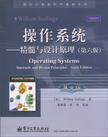操作系统
出版时间:2010-8 出版社:电子工业出版社 作者:(美)斯托林斯 著,蒲晓蓉,周伟 改编 页数:604
Tag标签:无
前言
This book is about the concepts, structure, and mechanisms of operating systems. Its purposeis to present, as clearly and completely as possible, the nature and characteristics of modern-day operating systems.This task is challenging for several reasons. First, there is a tremendous range and vari-ety of computer systems for which operating systems are designed. These include single-userworkstations and personal computers, medium-sized shared systems, large mainframe andsupercomputers, and specialized machines such as real-time systems. The variety is not justin the capacity and speed of machines, but in applications and system support requirements.Second, the rapid pace of change that has always characterized computer systems continueswith no letup. A number of key areas in operating system design are of recent origin, and re-search into these and other new areas continues.In spite of this variety and pace of change, certain fundamental concepts apply consis-tently throughout. To be sure, the application of these concepts depends on the current stateof technology and the particular application requirements. The intent of this book is to pro-vide a thorough discussion of the fundamentals of operating system design and to relatethese to contemporary design issues and to current directions in the development of operat-ing systems.
内容概要
《操作系统:精髓与设计原理(第6版)(英文版)》是讲解操作系统的经典教材,全书不仅系统地讲述了操作系统的基本概念、原理和方法,而且以当代最流行的操作系统——Windows Vista、UNIx和Linux为例,全面清楚地展现了当代操作系统的本质和特点。与教材配套的专用站点,为教师和学生理解书中内容,提供了及时、生动的材料。 《操作系统:精髓与设计原理(第6版)(英文版)》既注重对操作系统经典知识的讲解,又紧密结合当代最新的操作系统发展趋势,可作为大学计算机专业双语教材和参考书,也可供从事计算机专业研究方向的专业技术人员参考。
作者简介
作者:(美国)斯托林斯(William Stallings) 改编:蒲晓蓉 周伟
书籍目录
Chapter 1 Computer System Overview 1.1 Basic Elements 1.2 Processor Registers 1.3 Instruction Execution 1.4 Interrupts 1.5 The Memory Hierarchy 1.6 Cache Memory 1.7 I/O Communication Techniques 1.8 Recommended Reading and Web Sites 1.9 KeyTerms, Review Questions, and Problems Appendix 1A Performance Characteristics of Two-Level Memory Appendix 1B Procedure Control Chapter 2 Operating System Overview 2.1 Operating System Objectives and Functions 2.2 The Evolution of Operating Systems 2.3 Major Achievements 2.4 Developments Leading to Modern Operating Systems 2.5 Microsoft Windows Overview 2.6 Traditional UNIX Systems 2.7 Modern UNIX Systems 2.8 Linux 2.9 Recommended Reading and Web Sites 2.10 Key Terms, Review Questions, and Problems Chapter 3 Process Description and Control 3.1 What is a Process? 3.2 Process States 3.3 Process Description 3.4 Process Control 3.5 Execution of the Operating System 3.6 Security Issues 3.7 UNIX SVR4 Process Management 3.8 Summary 3.9 Recommended Reading 3.10 KeyTerms, Review Questions, and Problems Programming Project One Developing a Shell Chapter 4 Threads, SMP, and Microkernels 4.1 Processes andThreads 4.2 Symmetric Multiprocessing (SMP) 4.3 Microkernels 4.4 WindowsVista Thread and SMP Management 4.5 Solaris Thread and SMP Management 4.6 Linux Process andThread Management 4.7 Summary 4.8 Recommended Reading 4.9 KeyTerms, Review Questions, and Problems Chapter 5 Concurrency: Mutual Exclusion and Synchronization 5.1 Principles of Concurrency 5.2 Mutual Exclusion: Hardware Support 5.3 Semaphores 5.4 Monitors 5.5 Message Passing 5.6 Readers/Writers Problem 5.7 Summary 5.8 Recommended Reading 5.9 Key Terms, Review Questions, and Problems Chapter 6 Concurrency: Deadlock and Starvation 6.1 Principles of Deadlock 6.2 Deadlock Prevention 6.3 Deadlock Avoidance 6.4 Deadlock Detection 6.5 An Integrated Deadlock Strategy 6.6 Dining Philosophers Problem 6.7 UNIX Concurrency Mechanisms 6.8 Linux Kernel Concurrency Mechanisms 6.9 Solaris Thread Synchronization Primitives 6.10 Windows Vista Concurrency Mechanisms 6.11 Summary 6.12 Recommended Reading 6.13 Key Terms, Review Questions, and Problems Chapter 7 Memory Management 7.1 Memory Management Requirements 7.2 Memory Partitioning 7.3 Paging 7.4 Segmentation 7.5 Security Issues 7.6 Summary 7.7 Recommended Reading 7.8 Key Terms, Review Questions, and Problems Appendix 7A Loading and Linking Chapter 8 Virtual Memory 328Chapter 9 Uniprocessor Scheduling 386Chapter 10 Multiprocessor and Real-Time Scheduling Chapter 11 I/O Management and Disk Scheduling Chapter 12 File Management Glossary References
章节摘录
插图:From the processor's point of view, the action for input is as follows. Theprocessor issues a READ command. It then saves the context (e. g., programcounter and processor registers) of the current program and goes off and doessomething else (e. g., the processor may be working on several different programs atthe same time). At the end of each instruction cycle, the processor checks for inter-rupts (Figure 1.7). When the interrupt from the I/O module occurs, the processorsaves the context of the program it is currently executing and begins to execute aninterrupt-handling program that processes the interrupt. In this case, the processorreads the word of data from the I/O module and stores it in memory. It then restoresthe context of the program that had issued the I/O command (or some other program)and resumes execution.Figure 1.19b shows the use of interrupt-driven I/O for reading in a block ofdata. Interrupt-driven I/O is more efficient than programmed I/O because it elimi-nates needless waiting. However, interrupt-driven I/O still consumes a lot of proces-sor time, because every word of data that goes from memory to I/O module or fromI/O module to memory must pass through the processor.Almost invariably, there will be multiple I/O modules in a computer system, somechanisms are needed to enable the processor to determine which device causedthe interrupt and to decide, in the case of multiple interrupts, which one to handlefirst. In some systems, there are multiple interrupt lines, so that each I/O module sig-nals on a different line. Each line will have a different priority. Alternatively, therecan be a single interrupt line, but additional lines are used to hold a device addressAgain, different devices are assigned different priorities.
编辑推荐
《操作系统:精髓与设计原理(第6版)(英文版)》是畅销书作者William stallirigs的力作,其第四版曾获得美国计算机科学与工程类教材大奖。《操作系统:精髓与设计原理(第6版)(英文版)》清晰、完整地讲解了现代操作系统的概念、结构和机制。这个新版本进行了完整的更新,以反映行业的最新进展。作者全面分析了操作系统设计的高级目标和挑战,然后在每个主要领域给出了权威的讲解:线程、并发性、内存管理、虚拟内存、处理器调度、输入/输出管理以及文件管理等。对每个领域,都用现实世界的例子进行了演示,从而强化了这些讨论。这些例子基于Windows Vista、LINIX、Unux以及其他同时期的操作系统。不管是研究人员还是专业读者,《操作系统:精髓与设计原理(第6版)(英文版)》都是理想的读物。全书讲解清晰、结构合理,并包含大量的教学支持材料,包括数百个经过仔细构思的实践性问题。主要特点为了使复杂的概念更清晰、更易理解,集成了新的动画项目支持,包括两个手工编程项目、研究项目、阅读/撰写报告任务以及写作任务配套网站WilliarT]Stalli rlgs.COlTI/OS/OS6e.html上的大量Web内容支持丰富的关键字/缩略词清单、推荐读物、词汇表等涵盖内容大量的Wirldows例子,针对Wirldows Vista系统进行了全面更新扩充并优化了并发性的内容全面讲解进程控制、线程、SMP和微内核对单处理器、多处理器和实时调度进行了详细探讨全面介绍如何管理内存、I/O、磁盘和文件
图书封面
图书标签Tags
无
评论、评分、阅读与下载
用户评论 (总计16条)
- 对深入学习操作系统的组成与构建,大有裨益
- 强烈建议进 第七版的 货!!! 另外 希望 能 收录 更多 外国影印版教材! 谢谢!
- 经典教材 但是自己还没怎么看
- 新版的教材哦~~还参加了活动~~质量不错~~速度也很快~~
- 正版 纸质也很好
- 头一次购买影印版书籍,印刷质量一般,纸张也一般。但是内容没的说,外国大学的操作系统教材。字偏小。
- 经典著作,主要是做到了深入浅出,
- what a work!
- 这是最让我不开心的一次网购,拿回来的时候包装就坏了,让我想不明白的是上边还有很多土,拿出书后发现书的后封面磨坏了,而且书上也有很多土,像是从土里刨出来的
- 看见英文版,本来打算买的.不经意间注意到封面上有改编字样.看了下目录,果然12章之后的内容都被删除了.不过,那些内容基本和操作系统本身没多大关系,而且讲的也并不深入.
- 質量很不錯,而且發貨速度也可以
- 关于计算机操作系统讲解全面细致。
- 运送过来没什么问题,质量ok
- 就是纸张不是太好,毕竟是英文原版,内容还是不错的,只有12章,不过足够看了
- 虽然说这本书完全删减了12章之后的内容,不过没太大影响。我们老师要求买这本教材,所讲的内容也只是1——12章的内容。这本书里的语言十分朴实易懂,而且描述很到位,熟悉了之后可以看得和中文一样快。又学了专业知识又提高了英语阅读能力,一举两得。
- 当年买过影音版第三版。可惜找不到了。这次买来再重新看下。会有更多了解。
